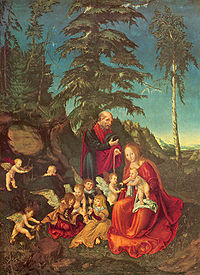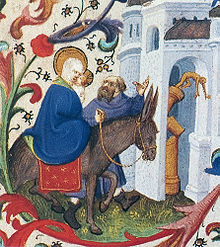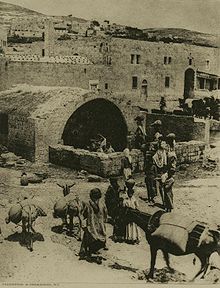- Flight into Egypt
-
For other uses, see Flight into Egypt (disambiguation).
The flight into Egypt is a biblical event described in the Gospel of Matthew (Matthew 2:13-23), in which Joseph fled to Egypt with his wife Mary and infant son Jesus after a visit by Magi because they learn that King Herod intends to kill the infants of that area. The episode is frequently shown in art, as the final episode of the Nativity of Jesus in art, and was a common component in cycles of the Life of the Virgin as well as the Life of Christ.
Contents
Matthew's gospel account
When the Magi come in search of Jesus, they go to Herod the Great in Jerusalem and ask where to find the newborn "King of the Jews". Herod becomes paranoid that the child will threaten his throne, and seeks to kill him (2:1-8). Herod initiates the Massacre of the Innocents in hopes of killing the child (Matthew 2:16-Matthew 2:18). But an angel appears to Joseph and warns Joseph to take Jesus and his mother into Egypt (Matthew 2:13).
Egypt was a logical place to find refuge, as it was outside the dominions of King Herod, but both Egypt and Palestine were part of the Roman Empire, making travel between them easy and relatively safe.
Return from Egypt
After a time Joseph and the others return from Egypt, the text stating that their enemies having died. Herod is believed to have died in 4 BC, and while Matthew doesn't mention how, the Jewish historian Josephus vividly relates a gory death.
 "Rest of the Virgin during The Flight into Egypt" by Lucas Cranach the Elder (1504, Staatliche Museen, Berlin).
"Rest of the Virgin during The Flight into Egypt" by Lucas Cranach the Elder (1504, Staatliche Museen, Berlin).
The land they return to is identified as Israel, the only place in the entire New Testament where Israel unambiguously acts as a geographic description of the whole of Judah and Galilee Matthew 2:20, rather than as referring to a collection of religious people or the Jewish people in general. It is however Judah that they are described as initially returning to, although upon discovering that Archelaus had become the new king of Judah, they fled to Galilee. Historically, Archelaus was such a violent and aggressive king that in year 6 he was deposed by the Romans, in response to complaints from the population. Galilee was ruled by a much calmer king, Herod Antipas, and there is historical evidence that Galilee had become a refuge for those fleeing the iron rule of Archelaus.
Prophecy of Hosea
Matthew Matthew 2:15 cites Hosea 11:1 as prophetically fulfilled in the return of Joseph, Mary and Jesus from Egypt:
"... and out of Egypt I called My son".
Matthew's use of Hosea 11:1 has been explained in several ways. A sensus plenior approach states that the text in Hosea contains a meaning intended by God and acknowledged by Matthew, but unknown to Hosea. A typological reading interprets the fulfillment as found in the national history of Israel and the antitypical fulfillment as found an event in the personal history of Jesus. Matthew's use of typological interpretation may also be seen in his use of Isaiah 7:14 and 9:1, and Jeremiah 31:15.
Another reading of Hosea's prophetic declaration is that it only recounts God summoning of the nation of Israel out of Egypt during the Exodus, referring to Israel as God's son in accordance with Moses' declaration to Pharaoh:
"Israel is my first-born son; let my son go, that he may serve me" (4:22-23).
The MT reads my son, whereas the LXX reads his sons; the MT is to be retained, the singular being both consonant with the singulars in Hosea 11:1 and with the reference to Exodus 4:22-23, and the LXX reading is to be explained as having been made to conform to the plurals of 11:2, they and them.
See also Hermeneutics and Jewish exegesis.
Extra-biblical accounts
Matthew's account is the only biblical reference to this flight, although there are many traditions about it reported in the New Testament apocrypha. These later works have a number of miraculous stories occurring on the voyage, with, for example, palm trees bowing before the infant Jesus, the beasts of the desert paying him homage, and an encounter with the two thieves that would later be crucified alongside Jesus. In these later tales the family is joined by Salome as Jesus' nurse. Matthew gives little detail about Jesus' family's time in Egypt, but there are a number of apocryphal tales filling in this period. These stories of the time in Egypt have been especially important to the Coptic Church, which is based in Egypt.
Throughout Egypt there are a number of churches and shrines that claim to mark an area where the family stayed. The most important of these is the church of Abu Serghis that claims to be built on the place the family had its home.
Historicity
Robert Funk of the Jesus Seminar has suggested that both Luke's and Matthew's birth and infancy accounts are fabrications.[1][2] A theme of Matthew is likening Jesus to Moses for a Judean audience, and the Flight into Egypt does just that.[3] Some skeptics interpret the passage as part of a lengthy justification for how Jesus could have grown up in Nazareth, a minor and little known town in Galilee, while still have been born in Bethlehem, which was a town of great religious importance because it was attached to King David.
In art
The Flight into Egypt was a popular subject in art, showing Mary with the baby on a donkey, led by Joseph, borrowing the older iconography of the rare Byzantine Journey to Bethlehem. Before about 1525, it usually formed part of a larger cycle, whether of the Nativity, or the Life of Christ or Life of the Virgin.
From the 15th century in the Netherlands onwards, it was more usual to show the non-Biblical subject of the Holy Family resting on the journey, the Rest on the Flight to Egypt, often accompanied by angels, and in earlier images sometimes an older boy who may represent, James the Brother of the Lord, interpreted as a son of Joseph, by a previous marriage.[4] The background to these scenes usually (until the Council of Trent tightened up on such additions to scripture) includes a number of apocryphal miracles, and gives an opportunity for the emerging genre of landscape painting. In the Miracle of the corn the pursuing soldiers interrogate peasants, asking when the Holy Family passed by. The peasants truthfully say it was when they were sowing their wheat seed; however the wheat has miraculously grown to full height. In the Miracle of the idol a pagan statue falls from its plinth as the infant Jesus passes by, and a spring gushes up from the desert (originally separate, these are often combined). In further, less commonly seen, legends a group of robbers abandon their plan to rob the travellers, and a date palm tree bends down to allow them to pluck the fruit.[5]
During the 16th century, as interest in landscape painting grew, the subject became popular as an individual subject for paintings, often with the figures small in a large landscape. The subject was especially popular with German Romantic painters, and later in the 19th century was one of a number of New Testament subjects which lent themselves to Orientalist treatment. Unusually, the 18th century artist Gianbattista Tiepolo produced a whole series of etchings with 24 scenes from the flight, most just showing different views of the Holy Family travelling.[6]
A subject taking place after the arrival in Egypt is the meeting of the infant Jesus with his cousin, the infant John the Baptist, who, according to legend was rescued from Bethlehem before the massacre by the Archangel Uriel, and joined the Holy Family in Egypt. This meeting of the two Holy Children was to be painted many artists during the Renaissance period, after being popularized by Leonardo da Vinci and then Raphael with works like Leonardo's Virgin of the Rocks.
Two plays of the medieval Ordo Rachelis cycle contain an account of the flight into Egypt, and the one found in the Fleury Playbook contains the only dramatic representation of the return from Egypt.
Gallery
-
Simple medieval wall-painting in a German church in Bochum-Stiepel
-
Presentation at the Temple and Flight, with legends of the idol and spring, Melchior Broederlam, Burgundy, c. 1400
-
The miracles of the palm tree and corn on the Flight, from a book of hours, ca. 1400
-
Joachim Patinir, 1510s(?), the inventor of the large landscape. At right the miracle of the corn, at top left the falling idol
-
The Flight into Egypt, Adam Elsheimer, c. 1605, as a night scene
-
Romantic Rest on the Flight by Philipp Otto Runge, 1806
-
Flight by Carl Spitzweg, 1875-9
-
British Orientalist artist Edwin Long, Anno Domini, 1883, shows the arrival in Egypt; the idols seem intact.
Nazarenes, Nazareth, and Nazarites
See also: Matthew 2:23While Luke places Jesus' family as being originally from the town of Nazareth, Matthew has the family moving there, though gives no specific reason for why they did so. Nazareth, now a town, is not mentioned by the Old Testament, Josephus or rabbinical sources,[7] though many Christian Bible archaeologists, such as the evangelical and egyptologist Kenneth Kitchen, state that they are fairly sure that a village existed in the area at the time of Jesus.[8] Clarke notes that the location of Nazareth is just to the north of where the large town Sepphoris was located. At the time, Sepphoris had been largely destroyed in the violence following the death of Herod the Great, and was being rebuilt by Herod Antipas, hence Clarke speculates that this could have been seen as a good source of employment by Joseph, a carpenter.
The difficulty with the brief quote he will be called a Nazarene is that it occurs nowhere in the Old Testament, or any other extant source. At the time the canon was not firmly established and it is possible that Matthew is quoting some lost source, although all the other quotations in Matthew are from well known works and if a prophecy so closely pointing to the town that Jesus grew up in existed, it would be likely to have been preserved by Christianity.[original research?]
The most similar known passage is Judges 13:5 where of Samson it says the child shall be a Nazirite, where a nazirite was a specific type of religious ascetic. That the Nazirite and Nazareth are so similar in name, while Nazareth isn't mentioned in any other source until after the Gospels have been written, and that the passage almost parallels one about the birth of a hero that was a Nazarite, has led many to propose that Matthew originally had Jesus being a Nazarite, but it was changed to Nazarene, inventing a location named Nazareth, when the ascetic requirements fell foul of later religious practices. Other scholars such as France reject this explanation, stating that Jesus was not a nazirite and claiming that he is never described as one.[who?]
Another theory is that it is based on a prophecy at Isaiah, which states that he grew up before him like a tender shoot — the Hebrew for shoot is nasir. While this piece of wordplay is meaningless in Greek, Hebrew wordplay is not unknown in Matthew, and so Goulder has proposed that the author of Matthew felt a need to justify as much as possible by prophecy, so looked for the closest thing he could find, which was this verse.
Christian traditions associated with the Flight into Egypt
A local French tradition states that Saint Aphrodisius, an Egyptian saint who was venerated as the first bishop of Béziers, was the man who sheltered the Holy Family when they fled into Egypt.[9] It is also held that the Holy family visited many areas in Egypt including Farama, Tel Basta, Wadi El Natrun, Samanoud, Bilbais, Samalout, Maadi, Al-Maṭariyyah[10] and Asiut among others.[11] It is also tradition that the Holy Family visited Coptic Cairo and stayed at the site of Saints Sergius and Bacchus Church (Abu Serga)[12] and the place where the Church of the Holy Virgin (Babylon El-Darag) stands now.
See also
- Christian Egypt
- Coptic Orthodox Church
- Massacre of the Innocents
- Rest on the Flight into Egypt (Caravaggio)
- Seven Sorrows of Mary
References
- ^ Funk, Robert W. and the Jesus Seminar. The acts of Jesus: the search for the authentic deeds of Jesus. HarperSanFrancisco. 1998. "Matthew," p. 129-270
- ^ Funk, Robert W. and the Jesus Seminar. The acts of Jesus: the search for the authentic deeds of Jesus. HarperSanFrancisco. 1998. "Luke," p. 267-364
- ^ Harris, Stephen L., Understanding the Bible. Palo Alto: Mayfield. 1985. "Matthew" p. 272-285
- ^ The subject only emerges in the second half of the fourteenth century. In some Orthodox traditions the older boy is the one who protects Joseph from the "shepherd-tempter" in the main Nativity scene. G Schiller, Iconography of Christian Art, Vol. I,1971 (English trans from German), Lund Humphries, London, p. 124 , ISBN 853312702.
- ^ Schiller:117-123. The date palm incident is also in the Quran. There are two different falling statue legends, one related to the arrival of the family at the Egyptian city of Sotina, and the other usually shown in open country. Sometimes both are shown.
- ^ Catalogued as Baudi di Vesme nos 1-27 (with three plates of frontispiece etc)
- ^ Perkins, P. (1996). Nazareth. In P. J. Achtemeier (Ed.), The HarperCollins Bible dictionary, pp. 741-742. San Francisco: HarperCollins. ISBN 0-06-060037-3.
- ^ Galilee.
- ^ St. Aphrodisius - Catholic Online
- ^ Egypt voyager
- ^ St Mary Mons
- ^ Coptic Cairo
Further reading
- Albright, W.F. and C.S. Mann. "Matthew." The Anchor Bible Series. New York: Doubleday & Company, 1971.
- Brown, Raymond E. The Birth of the Messiah: A Commentary on the Infancy Narratives in Matthew and Luke. London: G. Chapman, 1977.
- Clarke, Howard W. The Gospel of Matthew and its Readers: A Historical Introduction to the First Gospel. Bloomington: Indiana University Press, 2003.
- France, R.T. The Gospel According to Matthew: an Introduction and Commentary. Leicester: Inter-Varsity, 1985.
- France, R.T. "The Formula Quotations of Matthew 2 and the Problem of Communications." New Testament Studies. Vol. 27, 1981.
- Goulder, M.D. Midrash and Lection in Matthew. London: SPCK, 1974.
- Gundry, Robert H. Matthew a Commentary on his Literary and Theological Art. Grand Rapids: William B. Eerdmans Publishing Company, 1982.
- Jones, Alexander. The Gospel According to St. Matthew. London: Geoffrey Chapman, 1965.
- Schweizer, Eduard. The Good News According to Matthew. Atlanta: John Knox Press, 1975
External links
Flight into Egypt
Life of Jesus: The NativityPreceded by
Adoration of the Wise MenNew Testament
EventsFollowed by
Massacre of the InnocentsCategories:- Christian iconography
- Coptic Orthodox Church
- Gospel episodes
- Flight into Egypt in art
- Angelic apparitions
- Gospel of Matthew
-
Wikimedia Foundation. 2010.















